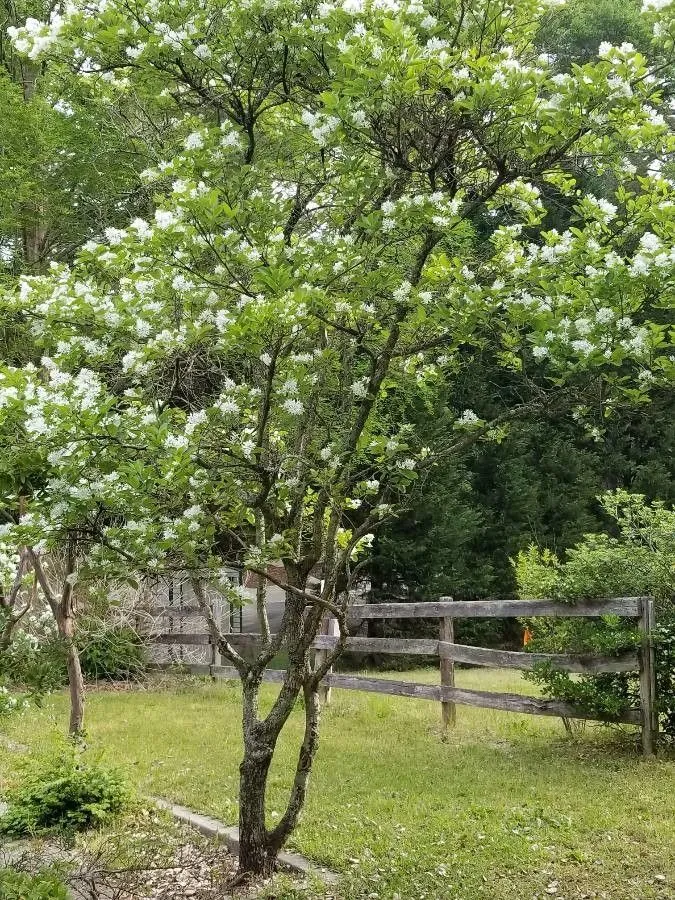
Author: L.
Bibliography: Sp. Pl.: 8 (1753)
Year: 1753
Status: accepted
Rank: species
Genus: Chionanthus
Vegetable: False
Observations: C. & E. U.S.A.
The American fringetree, scientifically named Chionanthus virginicus, is a striking and elegant deciduous shrub or small tree that is revered for its elaborate, fringed flowers and is native to the central and eastern regions of the United States. Descending from the distinguished Oleaceae family, this plant has a storied history dating back to its early classification documented in Linnaeus’s Species Plantarum of 1753.
The American fringetree is cherished for its breathtaking floral display. During late spring to early summer, it blooms in a magnificent cascade of delicate, creamy white flowers. These flowers, which resemble ethereal fringe or fine lace, lend the tree its common name. Their fragrance is subtle, adding a layer of sensory delight to their visual appeal.
Beyond its enchanting blooms, the tree features attractive, glossy green leaves that transition to a vibrant yellow hue in the fall, offering seasonal interest throughout the year. In the autumn, the tree also bears small, dark blue to black drupes that appeal to a variety of birds and wildlife, contributing to the biodiversity of its habitat.
The American fringetree typically reaches a height of 12 to 20 feet, making it an excellent choice for gardens, parks, and naturalistic landscapes. It can thrive in a variety of soil conditions, provided they are well-drained, and it tolerates both full sun and partial shade, demonstrating a commendable level of resilience and adaptability.
With its exquisite flowers, colorful seasonal foliage, and ecological benefits, Chionanthus virginicus holds a special place in horticulture and ecological landscaping. Its presence enhances not only the aesthetic aspect of gardens and green spaces but also supports native flora and fauna. Whether utilized as a focal point in a garden design or incorporated into a broader landscape strategy, the American fringetree stands as a testament to the natural beauty and diversity of the flora in the United States.
Eng: american fringetree, fringetree, old-man’s-beard, poison-ash, white fringetree
Fra: arbre de neige, arbre à franges
Swe: snöflockbuske
Deu: virginischer schneeflockenstrauch
En: American fringetree, Fringetree, Old-man‘s-beard, Poison-ash, White fringetree, American Fringe Tree, Old-man’s beard, Fringe Tree, Grancy Greybeard, Old Man’s Beard, Sweetheart Tree
Ar: زهرة الثلج
Da: Amerikansk Sneflokketræ
Fr: Arbre à franges, Arbre de neige, Arbre à neige
De: Virginischer Schneeflockenstrauch
Hu: Amerikai hópehelyfa
No: Virginiasommersnø
Pl: Śniegowiec wirginijski
Sr: Хионантус
Sv: Snöflockbuske
Taken Apr 23, 2021 by Abi Arfman (cc-by-sa)
Taken Nov 3, 2015 by EOL − Alexis Kleinbeck (cc-by-nc)
Taken Apr 10, 2021 by Linda D (cc-by-sa)
Taken Apr 26, 2019 by pascal revault (cc-by-sa)
Taken Apr 10, 2021 by Linda D (cc-by-sa)
Taken Jun 2, 2022 by Jochem Migchelbrink (cc-by-sa)
Taken Nov 26, 2021 by Leora Berns (cc-by-sa)
Taken Apr 4, 2022 by Rose Rose (cc-by-sa)
Taken Apr 4, 2022 by Rose Rose (cc-by-sa)
Taken Apr 23, 2021 by Abi Arfman (cc-by-sa)
Taken Apr 23, 2021 by C. bwood (cc-by-sa)
Taken Jun 11, 2022 by Wayne Lee (cc-by-sa)
Taken Apr 19, 2022 by Alix Janke (cc-by-sa)
Taken Jun 7, 2020 by Nancy Nancy (cc-by-sa)
Taken May 17, 2022 by CAROL CLAYTON (cc-by-sa)
Taken Apr 10, 2021 by Linda D (cc-by-sa)
Taken Apr 10, 2021 by Linda D (cc-by-sa)
Taken May 21, 2021 by Matthew DreamsOfBunnies (cc-by-sa)
Taken Jun 7, 2020 by Matthew DreamsOfBunnies (cc-by-sa)
Taken May 16, 2022 by Fabrice Rubio (cc-by-sa)
© copyright of the Board of Trustees of the Royal Botanic Gardens, Kew.
© copyright of the Board of Trustees of the Royal Botanic Gardens, Kew.
© copyright of the Board of Trustees of the Royal Botanic Gardens, Kew.
Taken May 24, 2010 by EOL − Chicago Botanic Garden 2010 (cc-by-nc-sa)
Taken Nov 3, 2015 by EOL − Alexis Kleinbeck (cc-by-nc)
Taken Jul 16, 2021 by Laurie Tanenbaum (cc-by-sa)
Taken Jan 27, 2021 by L. Ruiz (cc-by-sa)
Taken Oct 5, 2019 by Karen Q (cc-by-sa)
Taken Apr 23, 2021 by Teresa Teresa (cc-by-sa)
Taken May 30, 2022 by Mateusz Rolski (cc-by-sa)
Family: Myrtaceae Author: (F.Muell.) K.D.Hill & L.A.S.Johnson Bibliography: Telopea 6: 402 (1995) Year: 1995 Status:…
Family: Rubiaceae Author: Pierre ex A.Froehner Bibliography: Notizbl. Bot. Gart. Berlin-Dahlem 1: 237 (1897) Year:…
Family: Sapindaceae Author: Koidz. Bibliography: J. Coll. Sci. Imp. Univ. Tokyo 32(1): 38 (1911) Year:…
Family: Asteraceae Author: A.Gray Bibliography: Pacif. Railr. Rep.: 107 (1857) Year: 1857 Status: accepted Rank:…
Family: Fabaceae Author: Medik. Bibliography: Vorles. Churpfälz. Phys.-Ökon. Ges. 2: 398 (1787) Year: 1787 Status:…
Family: Aspleniaceae Author: (Cav.) Alston Bibliography: Bull. Misc. Inform. Kew 1932: 309 (1932) Year: 1932…